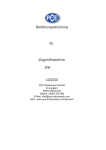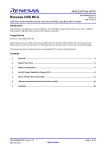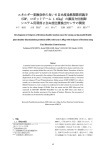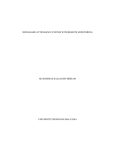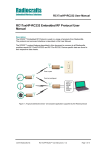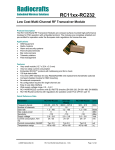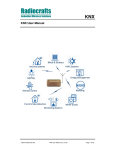Download Operating Instructions
Transcript
0
Operating Instructions
Z3 Z5 Z10
(Z20 Z50)
tensile tester
Z3 Z5
Z10
23.3.2011
Z20 Z50
1
Z3 3kN –Z5 5kN tensile tester
Z10 tensile tester 10 kN
3
OPERATING INSTRUCTIONS
Table of Content
Page
Section 1: Introduction
2
Section 2: Specification
3
Section 3: Checking Contents and the Number of Machine
4
Section 4: Power on checks
4.01 Power On/Off Switch
4.02 Emergency Stop Push Button
4.03 Mechanical Limit Switches
5
5
6
Section 5: Control Display Unit
5.01 Control Display Panel
5.02 Numeric Keypad
5.03 LCD –Display
5.04 Menu
7
8
10
11
Section 6: Configuration
6.01 Language Selection
6.02 Selection of the Units
6.03 Load Cell Capacity
6.04 Load Cell Sensitivity
6.05 Calibration Factor
6.06 Maximum Force of the Machine
6.07 Return Speed
6.08 Digits after the Decimal Point
6.09 Type of the Machine
6.10 Pre –Force Setting
12
12
12
12
12
12
13
13
13
13
Section 7: Load Cell
7.01 Fitting the Load Cell
7.02 Limits off the Load Cell
Zero Adjustment
7.04 Change off the Load Cell
7.05 Calibration with the Weight
15
15
15
15
16
Section 8: Interface RS23
17
7.03
4
SECTION 1: INTRODUCTION
1.01 This manual is to help the operator understand the operation of the
electronic panel of the machines.
These new testing machines are an easy-to-use range of compact machines
for determining Tension, Compression Shear, Flexure and other mechanical
and physical properties of materials. Due to variations in international
standards of units in force and extension, the tensile test machines have the
ability for the operator to select a one of two standards for Force Units
(Newtons and Pounds) and either Inches or Millimeters for the Extension
Units.
1.02 All the controls are located on the front panel, which has large, easy-toread backlit 2-line LCD display and a numeric keypad. The display unit
shows the force and displacement values. Crosshead control keys are
provided for moving crosshead up or down, or to start a test, or to get access
to various test parameters, for example, displacement or speed of crosshead.
The numeric keypad permits the inputting of test data.
1.03 There may be many aspects of material testing not covered in this
operation manual in particular the type of grips used and additional optional
equipment (for more information see our page in Internet:
1.04 All machines are provided for voltages 230 VAC or 115 VAC.
5
SECTION 2:GENERAL SPECIFCATIONS
These specifications apply to all models of the Tensile Test machines.
2.01 Force Measuring System - Full bridge strain gauge load cell of Z-Beam construction
for use in tension or compression. These interchangeable load cells are available
from the maximum capacity of the load frame, down to 5N.
2.02 Force Measuring Resolution - ±17 bit (=18 bit) of load cell capacity over the full
range (nominal).
2.03 Force Accuracy - ±0,5% of the indicated load from 2 to 100% of load cell capacity
and 1% down to 1% of the load cell capacity.
2.04:Force Sampling Rate - 50 Hz nominal (optional up to 800 Hz).
2.05 Extension Resolution - 0.001 mm (0.0001in.) of the full crosshead travel.
2.06 Operating Environment – All machines are designed to operate in temperatures of 0
to 38°C (32 to 100°F) with a non-condensing atmosphere of 10 to 90% Relative
Humidity.
6
SECTION 3: CHECKING CONTENTS
The machines are shipped completely assembled except for the optional accessories.
The basic machines are supplied with the following items, please insure that these are
included for the installation:
- Z-Beam Load Cell at or below the maximum capacity of the load frame;
- two Grip Pins (8 mm) for an adapter;
- operating instruction manual;
- load cell calibration certificate;
- one USB Serial Port Lead for external computer control;
- one 220 V cable.
The following diagrams are to help to identify each item:
Number Of Machine:
On the backside of each machine you find the number (Typ Nr.). Please use it for
future reference.
7
SECTION 4: POWER ON CHECKS
4.01 Power On/Off Switch The On (1) and Off (0) power switch is located on the back side
of the machine and should be in the Off (0) position before applying power to the machine.
The picture below indicates location of the power switch:
4.02 Emergency Stop Push Button The Emergency Stop push-button is located on the front
panel of the machine.
To activate the emergency stop you have to push the button. To deactivate the emergency
stop turn the button to the left and the button jumps out.
The picture below indicates location of the emergency stop push-button:
4.03 Mechanical Limit Switches Before attempting to move the crosshead in either direction
it will be required to set the mechanical crosshead limit switches. The purpose of the limit
switches is to reduce the travel of the crosshead enabling a safe working area. A typical
8
example is to protect the load cell and attachments for unforseen overtravel and in doing so
avoid a collision. These limit switches are located on the left hand side of the machine.
The diagram below shows the location of the mechanical crosshead limit switches:
The limit switches are held in position by a locking screw. To set the limit switch unlock by
turning the locking screw in an anti-clockwise direction and slide to the required new
position. To lock limit switch rotate locking screw in a clockwise direction. (Note: To
eliminate slippage re-tighten locking screw securely).
The diagrams below indicate mechanical crosshead limit switches:
Release Upper Limit Switch, move
crosshead to a new position, slide
limit switch to crosshead striker,
re-tighten.
Release Lower Limit Switch, move
crosshead to a new position, slide
limit switch to crosshead striker,
re-tighten.
9
SECTION 5 : CONTROL DISPLAY UNIT
5.01 Control Display Panel This unit contains the LCD Display, the Numeric Keypad and the
Emergency Stop push-button.
10
5.02 Numeric Keypad These keys are normally used for entering numeric values on the
LCD-Display (Speeds, Extension, etc.).
Crosshead Control Keys There are two crosshead directional arrows:
¾
The down arrow is used for lowering the crosshead
and for inputting negative values.
½
The Up arrow is used for raising the crosshead.
S
This key starts and stops a running test. If the [ Start – Stop] key is
pressed during a test, the procedure is interrupted. The same happens if
you press any other key.
The Menu Key
With this key the operator can make settings for the next test. The
adjusted settings should be confirmed with the Return key.
M
0
By pressing the [Return] key the operator stops or returns the
crosshead to zero extension after the test.
This key will zero the Force and Extension display.
11
1
This key shows the maximum Force and the referring Extension
of the last test.
2
This key shows the Force and the Extension of the Rupture.
This key has no function.
This key has no function.
5
This key is used to enter the configuration menu. This menu is
protected with the password (09122).
This key has no function.
This key has no function.
8
This key allows switching to constant force mode.
This key has no function.
12
5.03 LCD DISPLAY
When you switch on the machine you get a massage about the Firmware, then you see the
following:
actual force
test speed
1435.23 N 50 mm/min
327.12 mm 100 mm
crosshead displacement
test extension
When the test is finished (i.e. when the extension is reached, or the maximum force is
exceeded, or the break of the specimen is detected) you see the maximum force of the last
test.
Maximum force
Fmax = 1435.23 N
Xmax = 345.33 mm
Position where the maximum force
was reached
By pressing the [2] key the operator gets information about the force at break.
.
Force at break
Fbreak = 1435.23 N
mm
Xbreak = 345.33
Displacement at
break
13
5.04 MENU
M
The [Menu] Key
With this key the operator can make settings for the next test. The
adjusted settings should be confirmed with the [Return] key.
If you press the [Menu] key, you will see the following:
ENDPOS - means “Test Extension”.
The range is possible from 1 mm to 540 mm (for the smallest version of
the machine), except for the length of grips and specimen. Positive
values mean tensile test; negative values mean compression test. In
order to change from – to + you have to press the [Down] key.
V - means “Test Speed”.
The range is from 0,5 mm/Min to 500 mm/Min (only positive values
are possible).
F-LIMITS - means “Force Limit”.
The Force Limit can be used to protect tooling rated lower than the
load cell capacity, to end a test when that force is reached.
F-DELTA - means Force Delta.
Force Delta is the sensitivity for detecting the rupture of a specimen,
i.e. the value of 200N means, if during a tensile mode the load
decreases more than 200N/50ms, the rupture is detected and the test is
finished.
i value is too low rupture is not detected by the maschine and runs till
end of setted movement
F-MAN - means Jog Speed.
The range is possible from 1 mm/Min to 500 mm/Min.
14
SECTION 6: CONFIGURATION
By pressing the [M] key during the switching on the machine until the “Password” is
shown on the Display, or by pressing the [5] key the operator enters the configuration
menu. To prevent an accidental change of configuration data this menu is protected
with the password.
The procedure is as follows:
By pressing the [5] key the display shows “Password?”; the operator should press
“09122” and after that the settings of the machine can be changed.
6.01 Language Selection:
LANGUAGE:
German =1
1
½¾
With these keys the operator can choose the desired language and with the [Return]
key confirm the choice.
The operator can also select the desired language:
1
2
3
4
5
6
=German
=English
=Italian
=French
=Spanish
=Danish
( add a new language
http://www.youtube.com/watch?v=LDNiQRc5TIQ&feature=youtu.be )
6.02 The Selection Of The Used Units:
Selected :1 (SI)
Units: 1 [1-SI,2-Eng]
new:
Here 1 for N and .mm
or 2 for lbf and.inch
If you use the system “Millimeters/Newtons (mm/N), you have to press [1]; if you use
the system “Inches/Pounds (in/lbf), press [2].
By pressing the [Return] key you go to the next Menu-Entry.
6.03 Load Cell Capacity:
Loadcell 2000 N is
Loadcell: 2000 N
new:
15
Here enter the changed value and
confirm with the [Return] key
6.04 Load Cell Sensitivity:
sensitivity of 3.145 mV/V is selected
mV/V:
new:
3.145
Here you have to enter the changed value from data sheet
and confirm with the [Return] key
6.05 Calibration Factor:
Calibration factor is 1.0
Cal =
neu:
1.0
Here you have to enter the changed value
and confirm with the [Return] key
If you enter [0]”, you start a calibration program (see: “Change of the load cell”).
6.06 Maximum Force of the Machine:
Maximum force is 1999 N
(maximum capacity of the load cell –1N)
FlimitH = 1999 N
new
Here you have to enter the changed value and confirm with the
[Return] key
When the amount of the force is exceeded, the machine is automatically switched off and an
emergency massage is shown.
.
6.07 Return Speed: Return Speed is the speed for the Return key
(“Return home function”).
Return Speed is 500 mm/min
VR = 500 mm/min
new
Here you have to enter the changed value and confirm with the
[Return] key
6.08 Digits After The Decimal Point:
16
One digit after the decimal is shown
Prec : 1 [1.2]
new
Here you have to enter the changed value and confirm with the
[Return] key
“Prec” means “precision.
6.09 Type Of The Machine:
The “Machine type” can be set from 1 to 6 with the following meaning:
1 for TH 2730 3 kN (40 W, 500mm);
2 for TH 2730 3 kN (40 W, up to 1200 mm (a long version));
3 for TH 2730 5kN (80 W, 500 mm);
4 for TH 2730 5 kN (80 W, up to 1200 mm (a long version));
5 for TH 3630 10 kN (2x80 W, 500 mm);
6 for TH 3630-1000 10 kN(2x80, up to 1200 mm (a long version)).
6.10 Pre-force setting:
Pre-force amounts 0.0 N
F0 = 0.0 N
new
Here you have to enter the changed value and confirm with the
[Return] key
If the actual force exceeds the pre-force during the tensile test, or drops below the preforce during the compression test, the extension measurement begins with 0.00 mm.
This function is ineffective when the pre-force amounts 0 N.
All settings are power-failure safe stored.
PreForce Function
17
tensile test
force
F0
displacement is set to zero
displacement
-3
-2 -1
0
0
displacement is set to zero
-F0
Compression test
1
2
3
18
SECTION 7: LOAD CELL
7.01 Fitting Load Cell:
The Z-Beam type load cell are mounted under the moving crosshead. Your machine
will be provided with a load cell equal to or less than the maximum capacity of the
machine. These interchangeable Load Cells are available in capacities from 3 kN
down to 5 N. Connect the load cell by plugging the 5 pin connector into the load cell
socket on the rear side of the machine.
7.02 Limits of the Load Cell:
Load Cell should not be deformed more than maximum 0,2 mm in both directions.
By doing pressure tests be sure that you do not bend a load cell to the side. Using a
low force load cell there is a high risk of its damage by permanent bending of the load
cell which is due to its constructive principle. If there is danger of the load cell
overload we recommend to use special protection equipment which we also provide
After overload the load cell still shows measurements but they are not linear anymore.
That is why we recommend to use pneumatic grips for low force tests to avoid an
accidental destruction of the load cell when tightening the clamps.
To ensure the accuracy of the load cell a calibration test should be done with different
weights. If it is necessary adjust also the calibration factor.
We can only provide the load cell function as guaranteed by the manufacture. Any
claims which are due to false fixing or overload are not accepted.
7.03 Zero Adjustment:
By pressing the [1] key before testing zero adjustment is done.
As already the clamping of specimen produces force zero adjustment should be always
done before each test.
7.04 Change of the Load Cell:
In order to change the load cell you have to do the following:
1. switch off the machine;
2. loosen the fixing screw at the crosshead;
3. mount a new load cell with the fixing screw at the crosshead;
4. put a load cell plug into the connector on the back side of the machine;
5. switch on the machine.
Each load cell has its own capacity, sensitivity and a calibration factor. That is why
each time after the change you have to enter new values.
It is done as follows:
1. press the [5] key;
2. enter the password “09122”;
3. save old parameters on a piece of paper and enter new values (from data-sheep):
- load cell capacity, e.g. 3 kN;
- load cell sensitivity, e.g. 3.1324mV/V;
- set calibration factor to “1”.
With these values you will reach approx. 1% accuracy of the load cell capacity.
19
7.05 Calibration With The Weight:
In order to increase the accuracy of the machine you have to calibrate with the weight.
It is done as follows:
- remove load from the load cell (if there is any);
- set calibration factor to “0.
The display shows the following:
(Do not be confused that the display shows the messages in German, - this program is
used seldom, that is why we did not translate into English. On the right side of the
page you see the messages translated into English).
mit Gewicht eichen
weight calibr. 1=ok
Calibrate with weight
Weight calibr. 1=ok
Confirm with the [1] key, then you see the following:
Lastzelle entlasten
weiter mit Taste
Remove load from the load
cell
When the machine does not vibrate, press any key.
Last aufbringen
weiter mit Taste
Burden the load
Now hang a known weight on the load cell, wait till it is motionless and then press any
key.
Faktor bestimmen
weiter mit Taste
The machine calculates the
factor
Press any key.
Faktor bestimmen
15%
The machine calculates the
factor
15%
The machine calculates now the factor automatically, it counts from 1 till 100%.
When the procedure is completed, the machine awaits that the operator enters the force
that the load cell was loaded with.
Last: 38.460 N
Neu:
The pre-set force is 38.460 N
Enter the loaded force
20
Now you have to enter the force that the load cell was loaded with.
38.46 N
Last ok=1 again=9
The actual force is 38.46 N
Force ok =1 again=9
Because of the vibrations of the machine the last digit of the force reading is not stable.
The average value should be the same as the weight. When you are satisfied with the
calibration, press the [1] key and you will end the routine. If you press the [9] key, you
start the procedure once again.
The display shows the calculated calibration factor.
Faktor ist gesetzt:
1.003
The factor is set:
1.003
Video
http://www.youtube.com/watch?v=pyShrv
-ilYw&feature=youtu.be
21
SECTION 8 INTERFACE USB
1.0
Table of orders for TH 2730
(for software up to ver.4.35)
ORDE
R
FUNCTION
EXAMPL
E
RESULT
End of commands is always $
*
Decimal separator is '. '
'A'
Actual readings
A$
Force ;Way
'B'
Last readings (rupt. value)
B$
Frupt Xrupt
'C'
Write configuration data block
C$
Receive Conf. Data
'Dxxx' Set F delta
D20$
F delta=20N
'E'
Return to zero position
E$
Return button (to 0,00mm)
'Fxxx' Set limit of force in test (F limitS)
F200$
F limitS=200N
'G'
Read configuration data block
G$
Send Confg. data to comp.
'H'
Stop machine
H$
Stop button
'H?'
Ask for listing command set
H?$
Command set listing
'Jxxx' Set return speed
J200$
VR=200 mm/min
'K0'
Set normal mode
K0$
Machine in Normal mode
'K1'
Set Constant Force Regulation mode
K1$
Machine in CFR mode
'Lxxx' Set end position for test
L100$
X=100mm
'M'
Last readings (max. value)
M$
Fmax Xmax
'N'
Read nominal load
N$
2000 (Load cell = 2000N)
'O'
Reset Load cell and position counter
O$
0,0N 0,00mm (“0” button)
'O1'
Reset position counter only
O1$
2,0N 0,00mm
'O2'
Reset Load cell only
O2$
0,0N 7,34mm
'Pxxx' Set preforce (F0)
P0.4$ *
F0=0.4N
'Qxxx' Set constant force to keep (in CFM)
Q200$
Force to keep = 200N
'QTxxx' Set time to keep (in CFM)
QT60$
Time to keep = 60sec
'QHxxx' Set stiffness factor of sample (1..10)
QH1$
1 – slow regulation “hard”
'R'
Begin the Test
R$
Start button
'RHxx Begin the Hysteresis Test with:
RH10 2$ 2 cycle with 10 sec waiting
yy'
xx –delay time, yy –cycles
time
(repeating)
'RESET' Hard reset
RESET$ Reset of system
'S'
Ask for Status
S$
Condition of machine
'SER?' Ask for serial number of machine
SER?$
0001 (max 20char.)
'SER:' Set serial number in machine
SER:0001$ Set ser.# 0001 (max 20char.)
'T'
Read software ver. nr. in Flash
T$
" HEX-4.35 7. 2005 "
mem.
'U'
Ask for actual units (US or SI)
U$
1-SI system, 0-Us system
'Vxxx' Set speed testing speed
V100$
V=100mm/min
'Xxxx' Move to position with “Return
X20$
Drive to position of 20mm
22
speed” (Jxx)
1.01.1
Pin 1=DCD
Pin2=RxD
Pin3=TxD
Pin4=DTR
Pin5=GND
Pin6=DSR
Pin7=RTS
Pin8=CTS
Pin9=RI
Data format :
Baud rate
Data
Parity
Stop bits
Protocol
38400
8
None
1
none
Serial communication port :
Z3 Z5 Z10 manual
Page 0
1.01.2
Transferexample:
Character possibility:
„A“ -actual readings
„M“ -last readings of max. value(Fmax ; Xmax)
„B“ -last readings of break(Fbreak ;
Xbreak)
A 2 3 .3 ;4 5 . 6 0 ( C R /L F )
„S“ -status of machine
„E“ -machine return to zero position
„R“ -test is running
„OK“ -reset of Load cell and position
C h r a c te r
F o rc e
W ay
is done
EOF (ASCII=26)-end of data, end of
test
Force
Way
C a r r ia g e R e t u r n
L ine Fe e d
= 23.3N
= 45.60mm
1.02
C 251 Compiler Communication procedure.
…
switch(combuffer[0])
{
case 'R':versuch(0);
break;
case 'E':moveto(wegoffset,Tconfig.VR);
printf("E\n\r");
break;
case 'H':mstop();
break;
case 'O':adnullen();
printf("OK\n\r");
break;
case 'A':printf("A% 6.*F;% 6.2F\n\r",Tconfig.nachkomma,getkraft(),getweg());
break;
case 'M':printf("M% 6.*F;% 6.2F\n\r",Tconfig.nachkomma,fmax,xmax);
break;
case 'B':printf("B% 6.*F;% 6.2F\n\r",Tconfig.nachkomma,frupt,xrupt);
break;
case '$':resetproc();
break;
case 'V':combuffer[0]=' ';
T=atof(combuffer);
if ((T>1)&&(T<1000)) Tparablock.SPEED=T;
break;
case 'L':combuffer[0]=' ';
T=atof(combuffer);
Z3 Z5 Z10 manual
Page 1
Tparablock.endpos=T;
break;
case 'X':combuffer[0]=' ';
T=atof(combuffer);
moveto(T,Tconfig.VR);
break;
case 'S':printf("S%d\n\r",status);
1.03
Delphi 3.0 Receive procedure (for exp.)
procedure Tform1.receive(s:string);
const status:word=0;
var s1,s2:string;
index1,index2:word;
y:tvaluesx;
begin
case s[1] of
'A':
Begin
index1:=pos(';',s);
s1:=copy(s,2,index1-2);
index2:=pos(#10,s);
s2:=copy(s,index1+1,index2-index1-1);
panel2.caption:=s2+'mm';
panel3.caption:=s1+' N';
end;
'R':
Begin
if status=0 then
begin
xychart1.clear;
timer1.enabled:=false;
inc(status);
end;
index1:=pos(';',s);
s1:=copy(s,2,index1-2);
index2:=pos(#10,s);
s2:=copy(s,index1+1,index2-index1-1);
panel2.caption:=s2+'mm';
panel3.caption:=s1+' N';
Y[0]:=strtofloat(s2);
Y[1]:=strtofloat(s1);
Y[2]:=0;
Y[3]:=0;
y[4]:=0;
xychart1.add(y);
end;
#26: begin
status:=0;
timer1.enabled:=true;
Z3 Z5 Z10 manual
Page 2
speichern1click(self);
end;
end;
end;
4)
Change of configuration
by pressing "Menu" during power on or "5" key you call the
config menu.
to prevent accidental change of configuration it is necessary to key
in the Code.
proceed as follows:
after pressing "5" key the display shows: " Paßwort ? "
now key in the number "09122" if you entered the code correctly
you can either load the pre-set values or change them.
display shows: Grundeinstellung ?
Ja=0
by pressing "0" the machine load the following values:
by pressing "Return" you skip the defaults.
defaults values:
language (Sprache)
UNITS
1=deutsch 2= english 3= italiano 4=francise
½ mm N / in lbf ( 1lbf = 4.44822 N / 1 in = 25.4 mm )
LOADCELL
load cell Sensitivity (Lastzellenempfindlichkeit)
Calibration factor (Kalibrierfaktor)
by pressing "0" you start a Calibration program
F limit H (maximum force for Hardware)
repositioning speed (Rücklaufgeschwindigkeit)
F(0) [N]
(preload) .
[N]
[mV/V]
[FAK]
2000
3.165 (example)
1.000
[N]
[VR]
1500 [N]
500mm/min
Z3 Z5 Z10 manual
Page 3
these settings are stored in a non volatile ROM and are re-established after every
power on.
We recommend to note all changes on a piece of paper.
Machine type
'Machine type' can be set to 1..6 value with following meaning:
'1' for small engine (40W), short machine (up to 500mm) TH 2730 3kN
'2' for small engine (40W), long machine (up to 1200 mm) TH 2730 3kN 1000mm Verfahrweg
'3' for big engine (80W), short machine (up to 500mm)
TH 2730 5kN
'4' for big engine (80W), long machine (up to 1200 mm) TH 2730 5kN <1000mm Verfahrweg
'5' for two big engines (80W -10kN), short machine (up to 500mm) TH 3630 10 kN
'6' for two big engines (80W -10kN), long machine (up to 1200 mm). TH 3630 10 kN <1000 mm
After update parameter is '0' and must be set to value between 1 and 6 ( '0' and '7' is not
allowed).
In machine without program (empty) this parameter is automatic set to '1'.
For more information see info-hex-3-65.txt file.
Z3 Z5 Z10 manual
Page 4
5)
Load Cell
5.1)
Limits of the Load Cell
The Load Cell mustn't be deformed more than max. 0.2 mm in pulling direction!
Doing pressure tests ensure that the Load Cell does not bend out to the side!
Specially using low force Load Cells there is a high risk of damage by permanent
bending of the Load Cell which is due to the Load Cells construction principle
In case there is a danger of Load Cell overload we recommend to use special
protection equipment which we also provide. (www.grip-engineering.com)
After overload damage the Load Cell may still show measurements, but is not linear
anymore.
This is why we recommend the use of pneumatic grips for low force tests to avoid
accidentally destruction of load cells when tightening the clamps.
To ensure the accuracy of a Load Cell a calibration test should be done with multiple
different weights. If necessary adjust the calibration factor .
We only can provide the Load Cell Function as guaranteed by the manufacturer
Interface/Huppert. Any warranty claims which are due to mal -operation or overload
will not be accepted.
5.2)
Zero adjustment
By pressing " 0 " before testing a Zero adjustment is done.
As already the clamping of probes does produce forces a Zero adjustment
should always be done before testing.
Z3 Z5 Z10 manual
5.3)
Page 5
change of load cells
Switch off power on the machine
-
loosen the screw at the cross bar
mount new load cell with the screw at the cross bar
put load cell plug into the connector at the back side of the machine
Switch on the machine again and wait to end of self test procedure
press "5"
type Password: "09122"
save old parameters on a piece of paper and type the new values
¾ set new parameter for ‘Loadcell’ e.g.: 2000 [N]
¾ set new parameter for ‘mV/V’
(load cell sensitivity) e.g.: 3.165 [ mV/N]
¾ set new parameter for ‘Cal’ (calibration factor) to "1"
set calibration factor with weight
put a calibration weight at the load cell, e.g. : 10 kg = 98.0665 N (**
the display should show a similar value
E.g. the display shows 95.6 N the calibration factor must be
increased:
from 1 to 1.03745 (use calculator)
check the changes with the weight again!
** (this is dependent to your location and valid for 45° northern /
e.g. at the
North pole it would be 98.32 N / at the Equator 97.80 N )
Mounting procedure of Load Cell
Caution!
Small type of load cells can easily be deformed especially by torsion
forces.
Never put torsion forces on the Load cell while tightening or loosen
probes and clamps
Z3 Z5 Z10 manual
Page 6
only hold the load cell at the upper part!-------------------------------right ↓
3OK.
--------------------------------------------------------------------------------wrong↓
do not mount like this! Load cell is likely to be destroyed .
³never
---------------------------------------------------------------------------------
Load cell have a fragile area with tiny parts and adjusted DMS strips inside.
These thin Stege can easily be deformed permanently by torsion forces.
Z3 Z5 Z10 manual
6)
Page 7
Interface USB
Table of orders for TH 2730
ORDE
R
'A'
'B'
'C'
'Dxxx'
'E'
'Fxxx'
'G'
'H'
'H?'
'Jxxx'
'K0'
'K1'
'Lxxx'
'M'
'N'
FUNCTION
End of commands is always $
*
Decimal separator is '. '
Actual readings
Last readings (rupt. value)
Write configuration data block
Set F delta
Return to zero position
F200$
Stop machine
Ask for listing command set
Set return speed
Set normal mode
H$
H?$
J200$
K0$
Set Constant Force Regulation
mode
Set end position for test
Last readings (max. value)
Read nominal load
Reset Load cell and position
counter
'O1'
Reset position counter only
'O2'
Reset Load cell only
'Pxxx' Set preforce (F0)
'Qxxx' Set constant force to keep (in
CFM)
'R'
Begin test
'RESET' Hard reset
'S'
Ask for Status
'SER?' Ask for serial number of
machine
'SER:' Set serial number in machine
'U'
A$
B$
C$
D20$
E$
Set limit of force in test (F
limitS)
Read configuration data block
'O'
'T'
EXAMPL
E
Read software ver. nr. in Flash
mem.
Ask for actual units (US or SI)
G$
K1$
L100$
M$
N$
RESULT
Force ;Way
Frupt Xrupt
Receive Conf. Data
F delta=20N
Return button (to
0,00mm)
F limitS=200N
Send Confg. data to
comp.
Stop button
Command set listing
VR=200 mm/min
Machine in Normal
mode
Machine in CFR mode
O1$
O2$
P0.4$ *
Q200$
X=100mm
Fmax Xmax
2000 (Load cell =
2000N)
0,0N 0,00mm (“0”
button)
2,0N 0,00mm
0,0N 7,34mm
F0=0.4N
Force to keep = 200N
R$
RESET$
S$
SER?$
Start button
Reset of system
Condition of machine
0001 (max 20char.)
O$
SER:0001 Set ser.# 0001 (max
$
20char.)
T$
" HEX-3.35 5. 2000 "
U$
1-SI system, 0-Us
system
Z3 Z5 Z10 manual
'Vxxx'
'Xxxx'
Page 8
Set speed testing speed
Move to position
V100$
X20$
V=100mm/min
20mm to up
Serial communication port :
Z3 Manual
Page 0
Pin 1=DCD
Pin2=RxD
Pin3=TxD
Pin4=DTR
Pin5=GND
Pin6=DSR
Pin7=RTS
Pin8=CTS
Pin9=RI
Data format :
Baud rate 384 Parity
RTS/CTS Handshake
None Stop bittocol
Transferexample:
Character possibility:
A 2 3 .3 ;4 5 . 6 0 ( C R /L F )
C h r a c te r
F o rc e
W ay
C a r r ia g e R e t u r n
L ine Fe e d
„A“ -actual readings
„M“ -last readings of max. value(Fmax ;
Xmax)
„B“ -last readings of break(Fbreak ;
Xbreak)
„S“ -status of machine
„E“ -machine return to zero position
„R“ -test is running
„OK“ -reset of Load cell and position is done
EOF (ASCII=26)-end of data, end of test
Force
Way
= 23.3N
= 45.60mm
C 251 Compiler Communication procedure.
…
switch(combuffer[0])
{
case 'R':versuch(0);
break;
case 'E':moveto(wegoffset,Tconfig.VR);
printf("E\n\r");
break;
case 'H':mstop();
break;
case 'O':adnullen();
Z3 Manual
Page 1
printf("OK\n\r");
break;
case 'A':printf("A% 6.*F;% 6.2F\n\r",Tconfig.nachkomma,getkraft(),getweg());
break;
case 'M':printf("M% 6.*F;% 6.2F\n\r",Tconfig.nachkomma,fmax,xmax);
break;
case 'B':printf("B% 6.*F;% 6.2F\n\r",Tconfig.nachkomma,frupt,xrupt);
break;
case '$':resetproc();
break;
case 'V':combuffer[0]=' ';
T=atof(combuffer);
if ((T>1)&&(T<1000)) Tparablock.SPEED=T;
break;
case 'L':combuffer[0]=' ';
T=atof(combuffer);
Tparablock.endpos=T;
break;
case 'X':combuffer[0]=' ';
T=atof(combuffer);
moveto(T,Tconfig.VR);
break;
case 'S':printf("S%d\n\r",status);
Delphi 3.0 Receive procedure (for exp.)
procedure Tform1.receive(s:string);
const status:word=0;
var s1,s2:string;
index1,index2:word;
y:tvaluesx;
begin
case s[1] of
'A':
Begin
index1:=pos(';',s);
s1:=copy(s,2,index1-2);
index2:=pos(#10,s);
s2:=copy(s,index1+1,index2-index1-1);
panel2.caption:=s2+'mm';
panel3.caption:=s1+' N';
end;
'R':
Begin
if status=0 then
begin
xychart1.clear;
timer1.enabled:=false;
inc(status);
Z3 Manual
Page 2
end;
index1:=pos(';',s);
s1:=copy(s,2,index1-2);
index2:=pos(#10,s);
s2:=copy(s,index1+1,index2-index1-1);
panel2.caption:=s2+'mm';
panel3.caption:=s1+' N';
Y[0]:=strtofloat(s2);
Y[1]:=strtofloat(s1);
Y[2]:=0;
Y[3]:=0;
y[4]:=0;
xychart1.add(y);
end;
#26: begin
status:=0;
timer1.enabled:=true;
speichern1click(self);
end;
end;
end;
Serial comunication port:
Pin 1=DCD
Pin2=RxD
Pin3=TxD
Pin4=DTR
Pin5=GND
Pin6=DSR
Pin7=RTS
Pin8=CTS
Pin9=RI
Data format:
Bit per second
Data bits
Parity
Stopbits
Protocol
38400
8
Keine
1
Kein
examples :
Z3 Manual
Character posibility:
“A” -actuall readings
“M” -last readings of max. value(Fmax;Xmax)
“B” -last readings of break(Fbreak;Xbreak)
“S” -status of maschine
“E” -maschin return to zero position
“R” -test is runing
“OK” -reset of Loadcell and position is done
EOF (ASCII=26)-end of data, end of test
Force
= 23.3N
Way
= 45.60mm
C 251 Compiler Comunication procedure.
switch(combuffer[0])
{
case 'R':versuch(0);
break;
case 'E':moveto(wegoffset,Tconfig.VR);
printf("E\n\r");
break;
case 'H':mstop();
break;
case 'O':adnullen();
printf("OK\n\r");
break;
case 'A':printf("A% 6.*F;% 6.2F\n\r",Tconfig.nachkomma,getkraft(),getweg());
break;
case 'M':printf("M% 6.*F;% 6.2F\n\r",Tconfig.nachkomma,fmax,xmax);
break;
case 'B':printf("B% 6.*F;% 6.2F\n\r",Tconfig.nachkomma,frupt,xrupt);
break;
case '$':resetproc();
break;
case 'V':combuffer[0]=' ';
T=atof(combuffer);
if ((T>1)&&(T<1000)) Tparablock.SPEED=T;
break;
case 'L':combuffer[0]=' ';
T=atof(combuffer);
Tparablock.endpos=T;
break;
case 'X':combuffer[0]=' ';
T=atof(combuffer);
moveto(T,Tconfig.VR);
Page 3
Z3 Manual
Page 4
break;
case 'S':printf("S%d\n\r",status);
break;
case 'F':combuffer[0]=' ';
T=atof(combuffer);
if (fabs(T)<CONFIG.GRENZLAST) Tparablock.LIMIT=fabs(T);
case 'D':combuffer[0]=' ';
T=atof(combuffer);
Tparablock.DELTA_F=fabs(T);
case 'P':combuffer[0]=' ';
T=atof(combuffer);
Tparablock.F0=fabs(T);
}
Delphi 3.0 Receive procedure ( for example )
procedure Tform1.receive(s:string);
const status:word=0;
var s1,s2:string;
index1,index2:word;
y:tvaluesx;
begin
case s[1] of
'A': Begin
index1:=pos(';',s);
s1:=copy(s,2,index1-2);
index2:=pos(#10,s);
s2:=copy(s,index1+1,index2-index1-1);
panel2.caption:=s2+'mm';
panel3.caption:=s1+' N';
end;
'R': Begin
if status=0 then begin
xychart1.clear;
timer1.enabled:=false;
inc(status);
end;
index1:=pos(';',s);
s1:=copy(s,2,index1-2);
index2:=pos(#10,s);
s2:=copy(s,index1+1,index2-index1-1);
Z3 Manual
panel2.caption:=s2+'mm';
panel3.caption:=s1+' N';
Y[0]:=strtofloat(s2);
Y[1]:=strtofloat(s1);
Y[2]:=0;
Y[3]:=0;
y[4]:=0;
xychart1.add(y);
end;
#26:begin
status:=0;
timer1.enabled:=true;
speichern1click(self);
end;
end;
end;
Cable: 9 pole 1:1 DCE-DTE
CTS Protocol!
Page 5
Z3 Manual
7)
Page 6
special programs for test machine
F(0) Mode
if F(0) Mode is set to “ 1 “ x will automatically be set to 0
if load will come to a special value (after touching the sample )
used for compression tests
constant force regulation
with key 8 you can switch to force regulation
with key Menue you can set force
for example 5 N makes tension 5 N
for example –5N makes compression 5 N
if you press Start key force regulation will be activated
machine drives slowly to this force
if you press again on key 8 you come back to normal constant speed
regulation
in constant force regulation modus you can change settings
depending on hardness of material from 1 to 10
Push button Menu of tensile tester
if material is weak push 1 reaction speed is high
if material is hard push 10 reaction speed is low
Z3 Manual
Page 7
8) number of machine
on backside of machine you can find this number
please use it if you have questions
9) Accessories
1 USB cable
1 110/220V cable
2 pins 8 mm for adapter
1 certification of load cell
grips see also
http://www.grip.de
Z3 Manual
Page 8
Z3 Manual
Page 9
Thümler GmbH
grip - engineering
____________________________________________________________________________
Hans Traut Str. 25
Tel.: 09122-78711
90455 Nürnberg
Fax.: 09122-73127
Germany
[email protected]
Declaration of Conformity
name and
location of producer::
Thümler GmbH 90455 Nürnberg Hans Traut Str. 25
name of machine
small tensile tester Z 3 Z5 Z10
directives
compiled with
EG Maschinenrichtlinie 89/392
und EWG 91/368, EWG 93/44
VDE 0100, VDE 0106, VDE 0113, DIN 57113 / EN 60204
VDE 0160, VDE 0660
VBG1, VBG4, VBG5, VBG7A, ZH1/456 und ZH1/597
low voltage directive (73/23/EEC) ('LVD')
EMC directive (89/336/EEC) ('EMC')
responsible
M. Thümler Dipl. Ing. (Univ.) Maschinenbauing.
function
Line, development, conception, construction
registered into the following handicrafts registers
- Elektromechanikerhandwerk Lfd. Nr. 92/09/132 BNR 0052159
- Maschinenbauerhandwerk Lfd. Nr. 87/13/062 BNR 0052159
Nürnberg, den 15.3.2004
......................................................................................
Z3 Manual
Page 10
10) Windowssoftware
you can download actual software, manual and hexfile from our software homepage
http://www.grip-soft.de
11) Rest
Adapter size of Z3 and Z10
Z3 Manual
Page 11
Z3 Manual
known mechanical problems
open screw in nut (top screw in machine )
Relase M6 screw in nut
close ( turn nut clockwise) while machine is under load
Or little wheel on engine is not probably glued we exchange engine (motor) - send it back
this is a case of warranty
Page 12
Z3 Manual
Page 13
Z3-X500 3kN 500 mm
Z3-X1200
Z3 Manual
Z10-X700
Page 14
10kN 700mm
Z10-X700-W600
inner width 600mm
Z10-X1200
Z3 Manual
Robuste Universalprüfmaschine
Baureihe: Z20 – Z50
Page 15
Z3 Manual
Page 16
Z3 Manual
Page 17
Mistakes:
Movement of Z10-X700 is only 500 mm
This is only limit of software (not limit of mechanic) you can't set end position more as 500mm.
Z10 use universal software from Z3-Z5.
In configuration menu (protected by password) exist parameter: "machine type" with value=5,
change this value to "6" and limit of max. end position will be now 1000mm.
Hints
you can activate a c compensation in settings
you make a measurement of a very stiff part in your grips
then you divide dF/dx and write this value to C compensation and activate
then you will only see movement of the sample not loadcell machine or grips
Autocalibration Limits of loadcell
24.4.08
In our software exist limits:
1<mV<6
( you can just use 1.001 mV/V value)
0,5<Cal<1,5
Any new load cell used with our machines must be calibrated (adapted to our electronic).
the best (most easy) way is to use auto calibration (embedded in software).
You will need some precision "check weight" elements (100g - 300g)
and some scale pan (dish) or something different to fix "check weight" on the load cell adapter.
Procedure:
1.
2.
3.
4.
5.
6.
7.
8.
9.
10.
11.
12.
13.
14.
15.
16.
install new load cell
in configuration menu (pass. 09122) set nominal load = 5 N
set mV/V = 1.001
set Cal = 0 (zero) -auto calibration will be activated
for question "mit Gewicht eichen?..." press key "1"
from now you have only 40 sec. for each answer (if time is over, you will need again repeat procedure from p.4)
now leave on load cell only scale pan (dish) with pin (this is "tara", we need measure only "check weight element") and
press "Return" key
now auto calibration will set "tara"
for message: "Last aubringen", install "check weight element" and press "Return" key
now auto calibration will calculate average weight
for message: "Last: 38.460" set weight in [N] of your "check weight element" (i.e. if you use 200g - set 1,961 N
(0,2*9,80665=1,96133 N))
now you get new calculated force (i.e. if you set 1,961N you will get about 1,96N)
if calculation was wrong and you need to repeat auto calibration press now key "9"
if calculation was OK, press key "1" to finish auto calibration set new calibration factor
now you will see new factor (i.e. 1,231)
this is end of auto calibration, you can go out of configuration menu.
Z3 Manual
Page 18
" max. Last / Motor gestoppt" <- such message is generated in two cases:
1. load cell is demaged (overloaded - bended) and show very big (positive or negative) load over
safety limit (~2900N)
2. A/D converter on main board don't work correctly (no valid conversions).
First case you can check:
•
•
when you connect anny different load cell - you can see normal load readings on the LCD
when you remove any load cells plug from the machine - load display is "running up" or "down"
until limit (open loop).
You can also send us old load cell to check or check it self on next machine (by next customer with our
ZPM).
New load cells we have on stock.
A.Urbanski service [email protected]
18-09-2008




















































